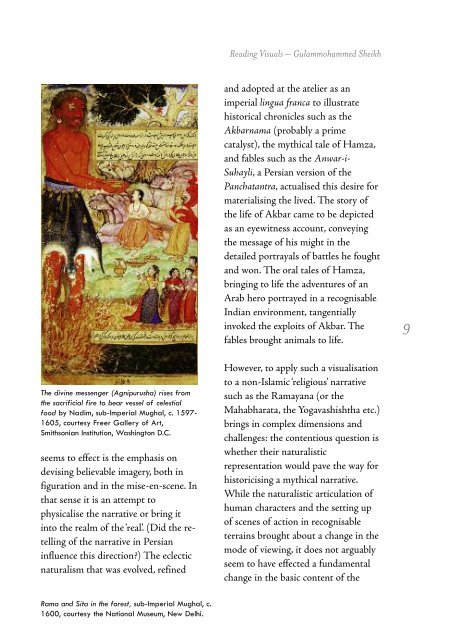Layout 3 - India Foundation for the Arts - IFA
Layout 3 - India Foundation for the Arts - IFA
Layout 3 - India Foundation for the Arts - IFA
You also want an ePaper? Increase the reach of your titles
YUMPU automatically turns print PDFs into web optimized ePapers that Google loves.
The divine messenger (Agnipurusha) rises from<br />
<strong>the</strong> sacrificial fire to bear vessel of celestial<br />
food by Nadim, sub-Imperial Mughal, c. 1597-<br />
1605, courtesy Freer Gallery of Art,<br />
Smithsonian Institution, Washington D.C.<br />
seems to effect is <strong>the</strong> emphasis on<br />
devising believable imagery, both in<br />
figuration and in <strong>the</strong> mise-en-scene. In<br />
that sense it is an attempt to<br />
physicalise <strong>the</strong> narrative or bring it<br />
into <strong>the</strong> realm of <strong>the</strong> ‘real’. (Did <strong>the</strong> retelling<br />
of <strong>the</strong> narrative in Persian<br />
influence this direction?) The eclectic<br />
naturalism that was evolved, refined<br />
Rama and Sita in <strong>the</strong> <strong>for</strong>est, sub-Imperial Mughal, c.<br />
1600, courtesy <strong>the</strong> National Museum, New Delhi.<br />
Reading Visuals – Gulammohammed Sheikh<br />
and adopted at <strong>the</strong> atelier as an<br />
imperial lingua franca to illustrate<br />
historical chronicles such as <strong>the</strong><br />
Akbarnama (probably a prime<br />
catalyst), <strong>the</strong> mythical tale of Hamza,<br />
and fables such as <strong>the</strong> Anwar-i-<br />
Suhayli, a Persian version of <strong>the</strong><br />
Panchatantra, actualised this desire <strong>for</strong><br />
materialising <strong>the</strong> lived. The story of<br />
<strong>the</strong> life of Akbar came to be depicted<br />
as an eyewitness account, conveying<br />
<strong>the</strong> message of his might in <strong>the</strong><br />
detailed portrayals of battles he fought<br />
and won. The oral tales of Hamza,<br />
bringing to life <strong>the</strong> adventures of an<br />
Arab hero portrayed in a recognisable<br />
<strong>India</strong>n environment, tangentially<br />
invoked <strong>the</strong> exploits of Akbar. The<br />
fables brought animals to life.<br />
However, to apply such a visualisation<br />
to a non-Islamic ‘religious’ narrative<br />
such as <strong>the</strong> Ramayana (or <strong>the</strong><br />
Mahabharata, <strong>the</strong> Yogavashishtha etc.)<br />
brings in complex dimensions and<br />
challenges: <strong>the</strong> contentious question is<br />
whe<strong>the</strong>r <strong>the</strong>ir naturalistic<br />
representation would pave <strong>the</strong> way <strong>for</strong><br />
historicising a mythical narrative.<br />
While <strong>the</strong> naturalistic articulation of<br />
human characters and <strong>the</strong> setting up<br />
of scenes of action in recognisable<br />
terrains brought about a change in <strong>the</strong><br />
mode of viewing, it does not arguably<br />
seem to have effected a fundamental<br />
change in <strong>the</strong> basic content of <strong>the</strong><br />
9


